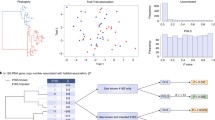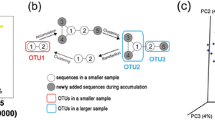Abstract
Comparative analyses of microbial communities increasingly involve the assay of 16S rRNA (or other gene) sequences from environmental DNA. Determining whether the composition of two or more communities differ in their phylogenetic composition involves testing for covariation between phylogeny and community type. This approach requires estimating the phylogenetic relationships among all sampled sequences and assessing whether the distribution of sequences among communities differs from the null expectation that sequences are randomly distributed. One method developed for implementing the phylogeny-based test of differentiation, referred to as the Phylogenetic test, relies on a single estimate of the phylogeny. However, for most data sets, many alternative phylogenetic trees provide statistically equivalent descriptions of the data. Because the actual phylogeny is unknown, phylogenetic tests of differentiation among microbial communities must account for phylogenetic uncertainty. In this article, we evaluate bootstrapping and Bayesian phylogenetic methods when implementing the Phylogenetic test using parsimony to map character states, and we investigate the effects of character mapping uncertainty by using a Bayesian approach to stochastically map character states on trees. Our approaches incorporate uncertainty into the tests of two closely related null hypotheses: (1) populations are panmictic, and (2) identical communites existed in both environments over the course of evolutionary history. We use two data sets previously implemented in tests for community differentiation: nitrite reductase genes sampled from marsh and upland soils and 16S rDNA sequences sampled from the human mouth and gut. We show that accounting for phylogenetic and mapping uncertainties can drastically affect results when implementing the Phylogenetic test. Accounting for phylogenetic and character mapping uncertainty provides a more conservative and robust test of covariation between phylogeny and environment when comparing microbial communities using DNA sequences.




Similar content being viewed by others
References
Acinas, SG, Klepac-Ceraj, V, Hunt, DE, Pharino, C, Ceraj, I, Distel, MF, Polz, MF (2004) Fine-scale phylogenetic arachitecture of a complex bacterial community. Nature 430(6999): 551–554
Alfaro, ME, Zoller, S, Lutzoni, F (2003) Bayes or bootstrap? A simulation study comparing the performance of Bayesian Markov chain Monte Carlo sampling and bootstrapping in assessing phylogenetic confidence. Mol Biol Evol 20: 255–266
Brauer, MJ, Holder, MT, Dries, LA, Zwickl, DJ, Lewis, PO, Hillis, DM (2002) Genetic algorithms and parallel processing in maximum-likelihood phylogeny inference. Mol Biol Evol 19(10): 1717–1726
Cummings, MP, Handley, SA, Myers, DS, Reed, DL, Rokas, A, Winka, K (2003) Comparing bootstrap and posterior probability values in the four-taxon case. Syst Biol 52: 477–487
Donachie, SP, Hou, S, Lee, KS, Riley, CW, Pikina, A, Belisle, C, Kempe, S, Gregory, TS, Bossuyt, A, Boerema, J, Liu, J, Frietas, TA, Malahoff, A, Alam, M (2004) The Hawaiian Archipelago: a microbial diversity hotspot. Microb Ecol 48: 509–520
Eckburg, PB, Bik, EM, Bernstein, CN, Purdom, E, Dethlefsen, L, Sargent, M, Gill, SR, Nelson, KE, Relman, DA (2005) Diversity of the human intestinal microbial flora. Science 308: 1635–1638
Felsenstein, J (1985) Confidence limits on phylogenies: an approach using the bootstrap. Evolution 39: 783–791
Giribet, G, Edgecombe, GD, Wheeler, WC (2001) Arthropod phylogeny based on eight molecular loci and morphology. Nature 413(6852): 157–161
Hackl, E, Zechmeister-Boltenstern, S, Bodrossy, L, Sessitsch, A (2004) Comparison of diversities and compositions of bacterial populations inhabiting natural forest soils. Appl Environ Microbiol 70: 5057–5065
Harvey, PH, Pagel, MD (1991) The Comparative Method in Evolutionary Biology. Oxford University Press. Oxford, UK
Heijs, SK, Damste, JSS, Forney, LJ (2005) Characterization of a deep-sea microbial mat from an active cold seep at the Milano mud volcano in the Eastern Mediterranean Sea. FEMS Microb Ecol 54: 47–56
Huelsenbeck, JP, Ronquist, FR (2001) MRBAYES: Bayesian inference of phylogeny. Biometrics 17: 754–756
Huelsenbeck, JP, Rannala, B, Masly, JP (2000) Accommodating phylogenetic uncertainty in evolutionary studies. Science 288: 2349–2350
Huelsenbeck, JP, Ronquist, F, Nielsen, R, Bollback, JP (2001) Bayesian inference of phylogeny and its impact on evolutionary biology. Science 2944: 2310–2314
Huelsenbeck, JP, Nielsen, R, Bollback, JP (2003) Stochastic mapping of morphological characters. Syst Biol 52(2): 131–158
Hughes, JB, Hellmann, JJ, Ricketts, TH, Bohannan, BJ (2001) Counting the uncountable: statistical approaches to estimating microbial diversity. Appl Environ Microbiol 67: 4399–4406
Keane, TM, Naughton, TJ, Travers, SA, McInerney, JO, McCormack, GP (2004) DPRml: distributed phylogeny reconstruction by maximum likelihood. Bioinformatics. 2004 Oct. 28
Kroes, R, Lepp, PW, Relman, D (1999) Bacterial diversity within the human subgingival crevice. Proc Natl Acad Sci USA 96: 14547–14552
Kumar, PS, Griffen, AL, Moeschberger, ML, Leys, EJ (2005) Identification of candidate periodontal pathogens and beneficial species by quantitative 16S clonal analysis. J Clin Microb 43: 3944–3955
Leache, AD, Reeder, TW (2002) Molecular systematics of the eastern fence lizard (Sceloporus undulatus): a comparison of parsimony, likelihood and Bayesian approaches. Syst Biol 51: 44–68
Ley, RE, Backhed, F, Turnbaugh, P, Lozupone, CA, Knight, RD, Gordon, JI (2005) Obesity alters gut microbial community. Proc Natl Acad Sci USA 102: 11070–11075
Maddison, WP, Maddison, DR (1993) MacClade, v. 3. Sinauer Press. Sunderland, MA
Maddison, WP, Slatkin, M (1991) Null models for the number of evolutionary steps in a character on a phylogenetic tree. Evolution 45: 1184–1197
Martin, AP (2002) Phylogenetic approaches for describing and comparing the diversity of microbial communities. Appl Environ Microbiol 68: 3673–3682
McGarvey, JA, Miller, WG, Sanchez, S, Stanker, L (2004) Identification of bacterial populations in dairy wastewaters by use of 16S rRNA gene sequences and other genetic markers. Appl Environ Microbiol 70: 4267–4275
Nielsen, R (2002) Mapping mutations on phylogenies. Syst Biol 51(5): 729–739
Pace, N (1997) A molecular view of microbial diversity and the biosphere. Science 276: 734–740
Posada, D, Crandall, KA (1998) Modeltest: testing the model of DNA substitution. Bioinformatics 14: 817–818
Prieme, A, Braker, G, Tiedje, JM (2002) Diversity of nitrite reductase (nirK and nirS) gene fragments in forested upland and wetland soils. Appl Environ Microbiol 68: 1893–1900
Ronquist, F (2004) Bayesian inference of character evolution. Trends Ecol Evol 19(9): 475–481
Schadt, CW, Martin, AP, Lipson, DA, Schmidt, SK (2003) Seasonal dynamics of previously unknown fungal lineages in tundra soils. Science 301: 1359–1361
Schloss, PD, Larget, BR, Handelsman, J (2004) Integration of microbial ecology and statistics: a test to compare gene libraries. Appl Environ Microbiol 70: 5485–5492
Schultz, TR, Churchill, GA (1999) The role of subjectivity in reconstructing ancestral character states: a Bayesian approach to unknown rates, states, and transformation asymmetries. Syst Biol 48(3): 651–664
Suau, A, Bonnet, R, Sutren, M, Godon, JJ, Gibson, G, Collins, MD, Dore, J (1999) Direct analysis of genes encoding 16S rRNA from complex communities reveals many novel molecular species within the human gut. Appl Environ Microbiol 65: 4799–4807
Suzuki, Y, Glazko, GV, Nei, M (2002) Overcredibility of molecular phylogenies obtained by Bayesian phylogenetics. Proc Natl Acad Sci USA 99: 16138–16143
Swofford, DL, Olsen, GJ, Waddell, PJ, Hillis, DM (1996) Phylogenetic inference. In: Hillis DM, Moritz C, Mable BK (Eds.) Molecular Systematics2Sinauer Press. Sunderland, MA, pp 407–514
Swofford, DS (2002) PAUP* 4.0. Sinauer Press. Sunderland, MA, USA
Theron, J, Cloete, TE (2000) Molecular techniques for determining microbial diversity and community structure in natural environments. Crit Rev Microbiol 26: 37–57
Acknowledgments
This work was supported by an NSF Microbial Observatory grant to S. Schmidt and A. Martin. Thanks are due to Steve Schmidt, Sasha Reed, and Elizabeth Costello for editorial comments. We thank J. Bollback for help with SIMMAP. We would also like to thank an anonymous reviewer who helped us immensely with the direction of this article.
Author information
Authors and Affiliations
Corresponding author
Rights and permissions
About this article
Cite this article
Jones, R.T., Martin, A.P. Testing for Differentiation of Microbial Communities Using Phylogenetic Methods: Accounting for Uncertainty of Phylogenetic Inference and Character State Mapping. Microb Ecol 52, 408–417 (2006). https://doi.org/10.1007/s00248-006-9002-7
Received:
Accepted:
Published:
Issue Date:
DOI: https://doi.org/10.1007/s00248-006-9002-7




